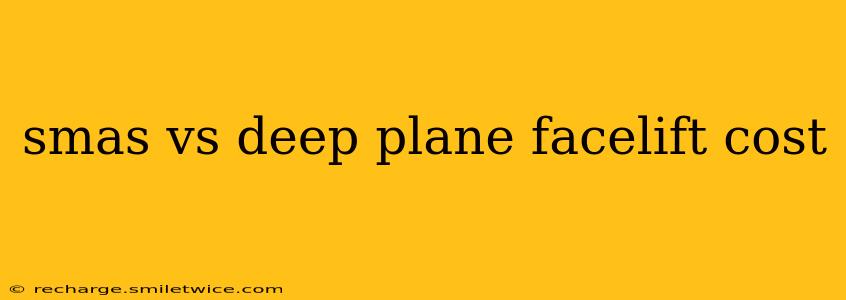Choosing between a SMAS facelift and a deep plane facelift is a significant decision, impacting both the aesthetic outcome and the financial investment. The cost of each procedure varies considerably depending on several factors, making it crucial to understand the nuances before committing. This guide will delve into the cost differences, influencing factors, and help you make an informed choice.
What is a SMAS Facelift?
A SMAS (Superficial Musculoaponeurotic System) facelift addresses the underlying muscle and connective tissue of the face. The surgeon lifts and tightens the SMAS layer, resulting in a more significant and longer-lasting lift compared to a traditional facelift. This technique targets sagging in the mid-face and jowls effectively.
What is a Deep Plane Facelift?
A deep plane facelift is considered the gold standard by many facial plastic surgeons. It involves lifting the deeper tissues of the face, including the SMAS layer and the deeper fat compartments. This meticulous technique results in a natural-looking lift and often produces more dramatic and longer-lasting results than a SMAS facelift, although recovery time may be longer.
How Much Does a SMAS Facelift Cost?
The cost of a SMAS facelift varies significantly based on geographic location, surgeon's experience, and the complexity of the procedure. Generally, you can expect to pay anywhere from $10,000 to $20,000 or more. This price usually includes the surgeon's fees, anesthesia, and the facility costs.
How Much Does a Deep Plane Facelift Cost?
Due to its increased complexity and the surgeon's expertise required, a deep plane facelift is generally more expensive than a SMAS facelift. Expect costs to range from $15,000 to $30,000 or more. Again, this cost includes the surgeon's fees, anesthesia, and the facility fees.
What Factors Influence the Cost?
Several factors significantly impact the overall cost of both procedures:
- Surgeon's Experience and Reputation: Highly experienced and renowned surgeons tend to charge higher fees. Their expertise and experience directly correlate with better outcomes and lower complication rates.
- Geographic Location: Costs vary widely depending on the location of the surgery. Procedures in major metropolitan areas often command higher prices than those in smaller towns or rural areas.
- Anesthesia: The type of anesthesia used (general or local) influences the overall cost.
- Facility Fees: The cost of using a surgical facility, hospital, or ambulatory surgical center varies significantly.
- Additional Procedures: If you choose to combine a facelift with other procedures like blepharoplasty (eyelid surgery) or brow lift, the total cost will increase substantially.
- Post-Operative Care: The cost of post-operative care, such as medications and follow-up appointments, should also be factored into your budget.
Are There Financing Options Available?
Many surgical practices offer financing plans to help patients manage the cost of cosmetic procedures. It's essential to discuss financing options with your surgeon's office during your initial consultation.
How Can I Find an Affordable Surgeon?
Finding an affordable surgeon doesn't necessarily mean compromising on quality. Thorough research is crucial. Consider consulting multiple surgeons to compare prices and expertise. Look for board-certified facial plastic surgeons who have a strong track record of successful procedures and excellent patient reviews. Remember, prioritizing cost above expertise could lead to unsatisfactory results or complications.
What are the Long-Term Costs Associated with Facelifts?
Beyond the initial surgical cost, consider potential long-term costs. These include:
- Follow-up appointments: Regular checkups after surgery are essential for monitoring healing and addressing any potential issues.
- Potential revisions: While rare, some patients may require revision surgery to address unexpected results or complications.
Choosing the Right Facelift Procedure: SMAS vs. Deep Plane
The choice between a SMAS and deep plane facelift should be made in close consultation with your surgeon. The best choice depends on your individual needs, facial anatomy, and desired outcome. Don't hesitate to discuss your priorities and concerns openly with your surgeon to determine the most suitable and cost-effective option for you.
This information is for general knowledge and does not constitute medical advice. Always consult with a qualified and board-certified plastic surgeon to discuss your specific needs and determine the best treatment plan for your situation.
